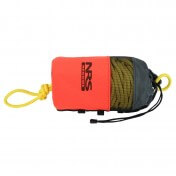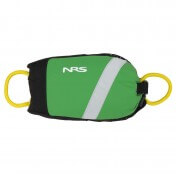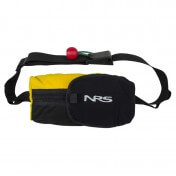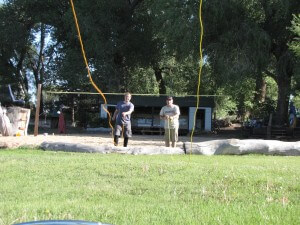
Rope Safety: How to Properly Use a Throw Bag

A discussion about rope safety and the proper use of a throw rope in whitewater rafting and whitewater rescue.
by Ben Costello, April 2016
To put it simply, a rope bag or throw bag is a bag filled with rope. It is a common river rescue tool that is carried on every raft at Mountain Whitewater. Most commercially available throw bags are made up of a nylon or Cordura bag filed with Polypropylene (or other floating material) rope. The ropes are made from a synthetic material that doesn’t lose its integrity when it gets wet. Max loads range from 950-2500+ lbs depending on the material. Ropes range in size and shape depending on their intended use. They will generally be made with bright colors and even reflective tape to ensure high visibility for the rescuer and the person being rescued.
There are bags designed to be worn around your waist, bags designed to be clipped onto a D-ring on your raft, bags designed to fit inside a small kayak and many others. Here are a few examples of throw bags that can be purchased from NRS:
Throw bag images courtesy of www.NRS.com
How To
The rope bag toss is one of the guide’s best ways to get guests to safety. Anyone that may have to throw a rope should practice regularly. As with most things, the better prepared you are for a rope toss through practice, the better you will perform when someone’s life is on the other end. Lucky for us, there is a road alongside much of the Cache La Poudre River. This allows our bus drivers to stop at the bigger rapids during high water to add another set of hands to help with throwing ropes.
When using a throw bag, there are several factors to consider. If possible, you should set-up before the rescue to ensure the best success. Trying to gain eye contact with the person to whom you’re throwing a rope. Swimmers are more likely to grab a rope if they see it coming and can look for it. Yelling “ROPE” before throwing a rope bag can also help gain the swimmers attention.
Most bags are best thrown with an underhand grip, though there are some that are designed to be thrown overhand. In order to throw a throw rope, you must hold the loose end of the rope with your non-throwing hand and grasp the bag firmly with your throwing hand. Make sure to leave about ten feet of “tail” on the loose end so you can let out some rope if needed. As you throw and release the bag it is VERY important that you don’t let go of the loose end…that’s what you’ll use to pull the swimmer in. When you throw, yell “rope” and aim straight at the swimmer’s head. As you throw the rope, the rope will unravel from the bag.
If you manage to hit the swimmer in the head, you’ve made a great shot. Now the swimmer only has to grab the rope to be pulled in instead of swimming to it. Hold firmly to the rope and make sure your swimmer does the same. If they hold the rope over their shoulder while floating on their back with their feet pointed downstream, it will be easier on both you and them. You can tow the swimmer back to the boat or shore or pendulum them towards shore or another boat to allow them to climb out on their own.
Some things to keep in mind…
- Make sure you have secure footing either on shore on the raft.
- Having another person that can help back you up is a great idea. It’s nice to have someone that can help you pull the swimmer to safety and make sure you don’t get pulled into the river yourself.
- Be aware of where the swimmer well end up after their pendulum to shore. Don’t swing them into any river hazard.
- Make sure you repack your throw bag properly after every time you use it to ensure easy unraveling and not a knotted mess.
- If possible, step toward your target as you throw to improve accuracy.
- Don’t release the rope to early or too late. Your release should aim the rope at your target.
- If there are several of you with a rope to throw, don’t all throw at the same time. This will prevent potentially dangerous tangling of the ropes.




















